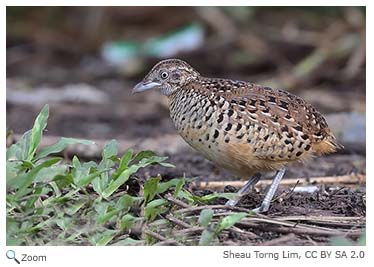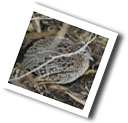Turnicidae -
Buttonquails |
|
|
 There are 18 species of small ground-dwelling birds found in this family. Buttonquails are found in warm regions in Europe, Africa, Asia, and Oceania. They are small, quail-like birds, 5-7 inches in length. There are 18 species of small ground-dwelling birds found in this family. Buttonquails are found in warm regions in Europe, Africa, Asia, and Oceania. They are small, quail-like birds, 5-7 inches in length.
Buttonquail live in scrubby grasslands and open woodlands. They have plump bodies, small heads, and small bills. They have three front toes and no rear toe. Buttonquails are usually a speckled brown and gray in color. Females are usually larger and more boldly colored than males.
Females mate with more than one male. Males incubate the eggs for 12-13 days and care for the chicks for about two weeks.
 Turnicidae Photo Gallery Turnicidae Photo Gallery
World Status Key
 Least Concern Least Concern  Near Threatened Near Threatened  Vulnerable Vulnerable  Endangered Endangered  Critically Endangered Critically Endangered  Extinct in Wild Extinct in Wild  Extinct Extinct  Not Enough Data Not Enough Data
Status and range is taken from ICUN Redlist.
Location Key
 Africa Africa  Asia Asia  Australia/Oceania Australia/Oceania  Europe Europe  North America North America  South America South America  NH NH  Click for More Info Click for More Info  Click for Image Click for Image
New Hampshire Species |
|
North/Central American Species |
None
|
|
None |
Additional Information
Key:  Profile Profile  Photos Photos  Video Video  Audio Audio
Sumba Buttonquail - Turnix everetti   
The Sumba buttonquail is found in Indonesia.
Source: Arkive Intended Audience: General Reading Level: Middle School Teacher Section: Yes
Chestnut-backed Buttonquail - Turnix castanotus   
The chestnut-backed buttonquail is found in Australia.
Source: Arkive Intended Audience: General Reading Level: Middle School Teacher Section: Yes
Black-breasted Buttonquail - Turnix melanogaster    
The black-breasted buttonquail is found in Australia.
Source: Arkive Intended Audience: General Reading Level: Middle School Teacher Section: Yes
Madagascar Buttonquail - Turnix nigricollis   
The Madagascar buttonquail is found in Madagascar.
Source: Animal Diversity Web Intended Audience: General Reading Level: Middle School Teacher Section: No
Hottentot Buttonquail - Turnix hottentottus   
The Hottentot buttonquail is found in South Africa.
Source: HBW Alive Intended Audience: General Reading Level: Middle School Teacher Section: No
Spotted Buttonquail - Turnix ocellatus   
The spotted buttonquail is found in the Philippines.
Source: Animal Diversity Web Intended Audience: General Reading Level: Middle School Teacher Section: No
Yellow-legged Buttonquail - Turnix tanki   
The yellow-legged buttonquail is found in Bangladesh, Bhutan, Cambodia, China, India, North Korea, South Korea, Laos, Myanmar, Nepal, Pakistan, Russia, Thailand, and Vietnam.
Source: Animal Diversity Web Intended Audience: General Reading Level: Middle School Teacher Section: No
Painted Buttonquail - Turnix varius   
The painted buttonquail is found in Australia.
Source: Animal Diversity Web Intended Audience: General Reading Level: Middle School Teacher Section: No
Common Buttonquail - Turnix sylvaticus     
The common buttonquail is found in central and southern Africa as well as in India and southeastern Asia and southern Spain.
Source: Animal Diversity Web Intended Audience: General Reading Level: Middle School Teacher Section: No
Quail-plover - Ortyxelos meiffrenii   
The quail-plover is also known as the lark buttonquail. It is found in Benin, Burkina Faso, Cameroon, Chad, Ethiopia, Ghana, Kenya, Mali, Mauritania, Niger, Nigeria, Senegal, South Sudan, Sudan, and Uganda.
Source: Animal Diversity Web Intended Audience: General Reading Level: Middle School Teacher Section: No
Barred Buttonquail - Turnix suscitator   
The barred buttonquail is found in Bangladesh, Bhutan, Cambodia, China, India, Indonesia, Japan, Laos, Malaysia, Myanmar, Nepal, the Philippines, Singapore, Sri Lanka, Taiwan, Thailand, and Vietnam.
Source: Animal Diversity Web Intended Audience: General Reading Level: Middle School Teacher Section: No
|